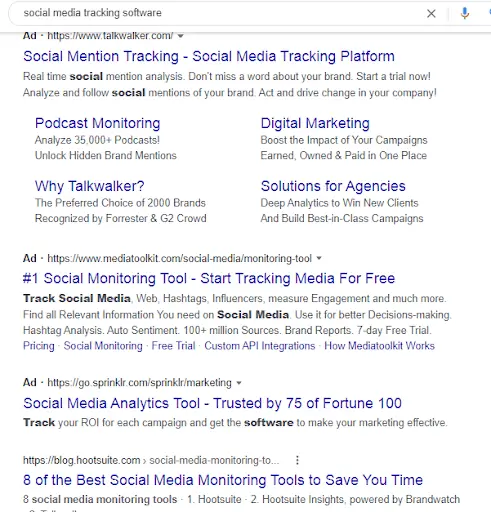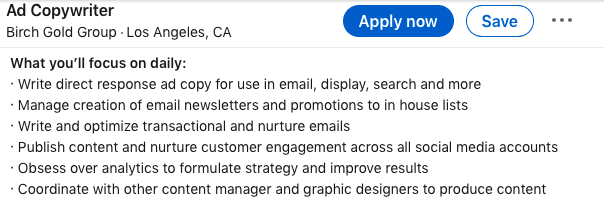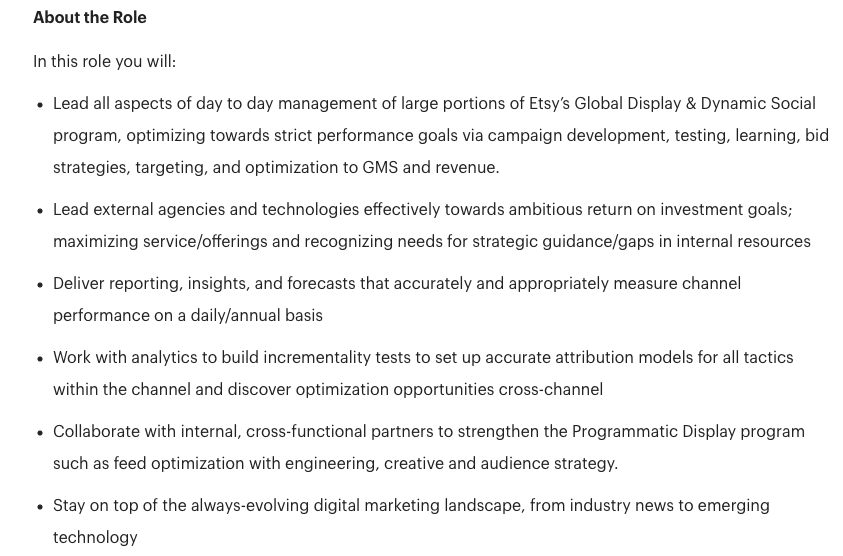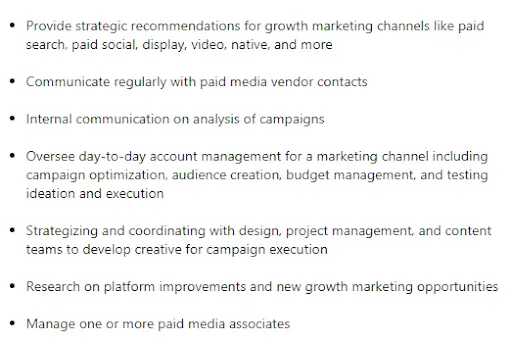You’ve heard of performance marketing, but what exactly is it? How does it work, and what are the benefits?
If you’re curious about performance marketing, you’ve come to the right place. In this guide, we’ll explain what performance marketing is, the nuts and bolts of how it works, and the benefits it can bring to companies. We’ll also explore what it looks like in the real world, and—for those interested in performance marketing roles—show you the job roles that fall under performance marketing today.
This article is for anyone looking to explore performance marketing as a career or use it for their business. Use the clickable menu if you want to skip ahead.
- What is performance marketing? A definition
- How does performance marketing work?
- Performance marketing channels
- What are the benefits of performance marketing?
- Performance marketing examples
- Performance marketing job titles and career paths
- Key takeaways and next steps
Ready to learn all about performance marketing? Let’s start with a definition.
1. What is performance marketing? A definition
The Performance Marketing Association defines performance marketing as follows:
“Performance Marketing is a comprehensive term that refers to online marketing and advertising programs in which advertisers (a.k.a., “retailers” or “merchants”) pay marketing companies (a.k.a, “affiliates” or “publishers”) when a specific action is completed; such as a sale, lead or click.”
So what does this actually mean?
As a marketer (or a company), you want to connect with your audience and bring attention to your product, service, or brand.
To do this, you might create an ad that’s shown to people on social media, or in the Google search results when they search for certain products. With performance marketing, you pay depending on how the campaign performs.
For example, you might pay every time a user clicks on your ad (pay per click), or whenever your campaign generates a sale.
Essentially, performance marketing flips the traditional marketing model on its head. Back when print advertising was more common, you might pay to have an advert printed in a magazine.
You’d invest the money and effort upfront, regardless of how the advert performs. With performance marketing, you pay based on the completion of an agreed-upon action after the ad is live. As the name suggests, it’s entirely performance-based.
With a working definition in mind, let’s explore performance marketing in more detail. Next up: How does performance marketing work?

2. How does performance marketing work?
At its core, performance marketing has two sides to it: One party that owns an audience, and another party (the marketer) who wants to reach that audience.
With performance marketing, the marketer pays to have access to that audience, compensating the platform or publisher (for instance, Facebook) who is hosting their marketing efforts (for example, paying the platform every time a user clicks on an ad the marketer is hosting there).
For example:
LinkedIn has over 774 million users who’ve displayed their professional information on the platform. That is valuable to advertisers looking to sell to these individuals. That’s part one of the performance marketing equation.
Through the LinkedIn ad platform, marketers can target their desired customer profiles and pay based on performance of specific actions such as clicks, downloads of whitepapers and ebooks, webinar sign-ups, and so on. This is the second part of the performance marketing equation.
Google offers the same to advertisers who want to reach audiences searching for products and services on the search engine. So does Instagram, Facebook, and all social media platforms you can think of.
Performance marketing can also work within smaller niche audiences and forms the basis of affiliate marketing.
Affiliate marketing is when blog, newsletter, or paid community owners charge marketers for access to their niche audiences. And using tracking software, marketers can attribute actions (a sale, a download, or a sign up) to each affiliate partner, paying them based on performance.
Measurement and attribution
You can track and measure performance marketing based on any agreed metric, but the following are the most popular:
CPC (Cost Per Click)
In this model, performance is defined by a click. In other words, you only pay when someone clicks on your ad. CPC is the default attribution model across many channels, as it requires low effort from the user.
The cost of each click is determined by competition between all advertisers competing for the same audience within the platforms. It varies depending on factors such as the advertizer’s bid amount, the quality of their ads, and the conversion rate.
Among niche performance marketing channels, e.g. newsletter affiliate programs, advertisers can negotiate the CPC based on the quality and relevance of the audience to the advertiser’s product.
CPL (Cost Per Lead)
With CPL, you measure performance based on the capture of a lead; i.e customer information such as an email address or a phone number, often obtained through offering people valuable content (ebooks, white papers and templates) in exchange for contact information.
With a CPL model, you only pay when a user completes the action that qualifies them as a lead.
CPA (Cost Per Action)
This performance measurement model is popular in affiliate marketing. A marketer and an audience owner, for example, a blogger, would agree on a desired action (purchase of a product, submission of a ‘get demo’ request, etc.), the audience owner would then introduce the marketer’s product to their audience and be compensated if the agreed upon action is completed.

3. Performance marketing channels
Now let’s explore the most popular channels used for performance marketing.
Search Engine Marketing (SEM)
As the name suggests, search engine marketing relies on traffic from search engines such as Google, Bing, and Yahoo. Advertisers pay search engines to show their landing pages when users search for terms related to their offerings, but they only pay when the user clicks to their website
To learn more about search engine marketing, check out our in depth article on the difference between SEM and SEO.
Native advertising
The premise of native advertising is to offer ads that blend into the publisher or social platform’s design aesthetics and are therefore less intrusive.
This includes articles you’d see on content platforms like the New York Times or Bloomberg with a ‘sponsored’ label, or content recommendations at the bottom of articles. They are meant to blend into the feeds.

You can also see sponsored content on social media news feeds. Here’s a screenshot from the Facebook news feed, which is labeled as sponsored content to differentiate it from organic content.

Affiliate channels
Affiliate marketing is a type of performance marketing where third parties introduce advertisers’ products to their audience for a cut of the sale or cash rewards.
Affiliate marketing relies on affiliate networks such as ClickBank and ShareASale that manage the affiliate relationships. Traditional affiliate marketing channels include blogs and websites.
Emerging channels include newsletters and private communities such as Facebook groups or Slack channels.
Social media platforms
Performance marketing is at the heart of social media platforms’ business models. Mature platforms with many creators, such as Facebook and Instagram, offer companies access to audiences through cost per click (CPC) performance ad models.
Growing channels (with less content creators than consumers), such as TikTok and LinkedIn offer a combination of free organic reach and paid performance marketing based reach.
4. What are the benefits of performance marketing?
There are many benefits of performance marketing. These include:
Increased reach
Compared to traditional advertising models such as newspaper adverts and organic channels such as SEO, performance marketing allows you to reach a large yet targeted audience.
For example, a marketer advertising in a small town newspaper has limited advertising slots and cannot target specific groups. However, using performance marketing channels such as social media, that reach can be extended with the message targeted to appeal to the most relevant people.
Attribution
Knowing what works and what doesn’t is helpful for marketers in deciding how to allocate resources. Performance marketing channels are designed to be able to tie performed actions to results (attribution).
Thus, it is possible to map specific channels and assets, e.g. whitepapers, to revenue, something that’s not always possible with other types of marketing.
For example, you can track and identify the content assets that have led to the most requests for product demos, calculate the percentage of demos that converted to buyers, compare that to the performance of other channels, and allocate resources accordingly. This is all crucial information for companies who want to use their resources wisely for maximum impact!
Low up-front acquisition costs
The less companies can spend on acquiring new customers, the longer the financial runaway they have. For companies competing against established, well-funded competitors, operating sustainably amidst increasing ad costs can be a challenge.
But using performance marketing channels such as affiliate relationships, you can tap into other people’s audiences and only pay them when their referrals make a purchase.
Here’s a graph showing the growth of Supermetrics, a marketing data company that was bootstrapped for 5 years before the founders raised money in 2019. Revenue from affiliate partners helped drive the growth.

Source: Latka interviews SuperMetrics Founder Mikael Thuneberg
Targeting
A study by Infolinks found that 86% of consumers experienced banner blindness; a phenomenon where consumers have learned to ignore ads. As such, targeting ads to the relevant audience is vital to getting a return on ad spend.
Performance marketing channels such as LinkedIn and Facebook provide detailed targeting options that allow you to narrow down targeting by factors such as job titles, interests, and online behavior.
And since you only pay when the target audience completes an action, targeting allows you to only attract people that will find your product relevant while sidestepping those audiences who are less likely to be interested. This reduces wasteful advertising.

5. Performance marketing examples
In this section, we’ll show you some real-world examples of performance marketing campaigns.
Performance marketing example 1: LinkedIn
Here’s a screenshot of a native ad on the LinkedIn news feed. Chances are you would click through without thinking of it as an ad because of how it’s been designed to blend in.

Performance marketing example 2: Google search results
Performance ads also appear on the Google search engine results page, just above the organic results. They’re tailored to the keywords used by searchers, and—apart from being labeled as ads—look just like the organic search results.

6. What job titles come under performance marketing?
Perhaps you’re reading up on performance marketing with a view to starting a career in the field. If that’s the case, you’ll want to know what kinds of job titles fall under the performance marketing umbrella. Let’s explore some potential career paths now.
Paid search marketing specialist
This is a specialist role with expertise pegged on the performance of past campaigns and the amount of ad budget you’ve managed before. Here is an extract from a paid search marketing specialist job ad, posted by AIG. Responsibilities range from managing budgets and analytics reporting, to collaborating with the media team to guide creative messaging and strategy.

Ad copywriter
While copywriters tackle different types of copy, there are roles that specifically require performance ad copywriting skills that can get target audiences to take action. Here’s part of an ad copywriter job description, posted on LinkedIn by the Birch Gold Group in Los Angeles.

Performance marketing manager
This role requires a combination of strategy (selecting the right performance marketing channels for the business) and execution (mastery of the different channels). Here is an extract from a performance marketing manager job ad posted by Etsy.

Paid media associate/manager/specialist
This role involves identifying the right performance marketing channels to target, as well as managing the creatives and vendors. Here’s a screenshot of a job description for this role.

Other job roles that utilize performance marketing skills and knowledge of performance marketing channels include growth marketing roles, demand generation, affiliate managers, paid search analysts, and digital marketing managers.
7. Key takeaways and next steps
In a nutshell, performance marketing involves all marketing activities where advertisers pay for access to target audiences after an agreed action is completed. Compensation is based on CPC (cost per click), CPL (cost per lead) or CPA (cost per action) as agreed between the advertiser and the advertising platform owner.
As such, knowledge of ad/affiliate marketing platforms, ad budget management and analytical skills are essential prerequisites to getting into performance marketing.
If you’d like to learn more about digital marketing, check out our free, 5-day short course. We can also recommend the following:
